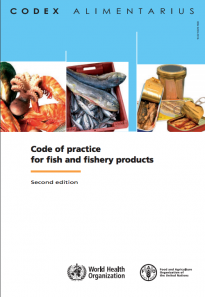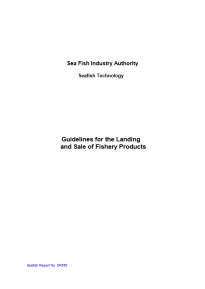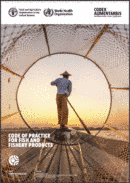Regulatory Environment for Urban Wholesale
A well-managed landing site with a robust set of rules properly applied will have high standards conducive to good quality and reduced food loss and waste (FLW).
The Codex Alimentarius Code of Practice for Fish and Fishery Products
The Codex Alimentarius Code of Practice for Fish and Fishery Products is a reference point for good wholesale market practices that can become legal requirements. The Code highlights that markets should be designed and constructed according to the following:
- Facility layout should be designed to minimize cross-contamination and may be accomplished by physical or time separation.
- All surfaces in handling areas should be non-toxic, smooth, impervious and in sound condition in order to minimize the build-up of fish slime, blood, scales and guts and to reduce the risk of physical contamination.
- Working surfaces that come into direct contact with fish, shellfish and their products should be in sound condition, durable and easy to maintain. They should be made of smooth, non-absorbent and non-toxic materials, and inert to fish, shellfish and their products, detergents and disinfectants under normal operating conditions.
- Adequate facilities should be provided for the handling and washing of products and should have an adequate supply of cold potable water for that purpose.
- Suitable and adequate facilities should be provided for storage and/or production of ice.
- Ceiling lights should be covered or otherwise suitably protected to prevent contamination by glass or other materials.
- Ventilation should be sufficient to remove excess steam, smoke and objectionable odours, and cross-contamination through aerosols should be avoided.
- Adequate facilities should be provided for washing and disinfecting equipment, where appropriate.
- Non-potable water lines should be clearly identified and separated from potable water to avoid contamination.
- All plumbing and waste lines should be capable of coping with peak demands.
- Accumulation of solid, semi-solid or liquid wastes should be minimized to prevent contamination.
- Where appropriate, containers for offal and waste material should be clearly identified, suitably constructed with a fitted lid and made of impervious material.
- Separate and adequate facilities should be provided in order to prevent contamination by:
- poisonous or harmful substances
- dry storage of materials, packaging, etc.
- – offal and waste materials
- Adequate hand washing and toilet facilities, isolated from handling area, should be available.
- Prevent the entry of birds, insects or other pests and animals.
- Water supply lines should be fitted with back-flow devices, where appropriate.
Guidance on handling and equipment are also included in the Code.
The Sydney Fish Market Rules
The Sydney Fish Market Rules
The rules of the Sydney Fish Market provide a useful guide for wholesale markets. The rules are designed to ensure the good order and conduct of the Market and in particular to:
- ensure, so far as is reasonably practicable the health, safety and well-being of all people in the Market
- ensure compliance with all relevant laws, especially those relating to health, safety and environmental protection
- to eliminate, or minimize so far as is reasonably practicable, the risks to the health and safety of workers and to other persons who attend the Market
- make the Market attractive to customers and ensure it remains competitive in the wider market place
- foster the continued growth and prosperity of the Market
Key Publications
Code of Practice for Fish and Fishery Products Codes of practice and guidelines designed to help meet standards and comply with legislation (e.g the Codex Alimentarius Code of Practice for Fish and Fishery Products). | |
Guidelines for the Landing and Sale of Fishery Products These guidelines provide advice on maintaining standards of fish quality and food safety, and on maximizing value through efficient landing and sale operations, and is an intended reference for trade and official bodies. |
More Resources
More Resources
31 October 2023













